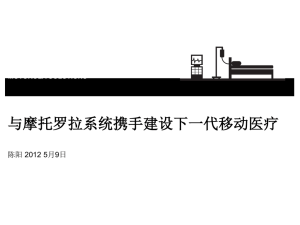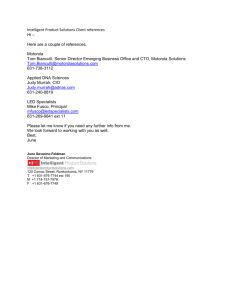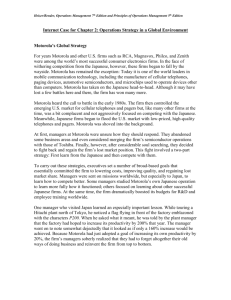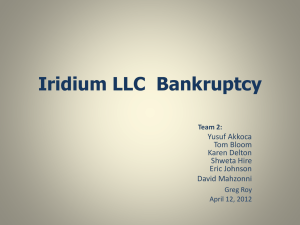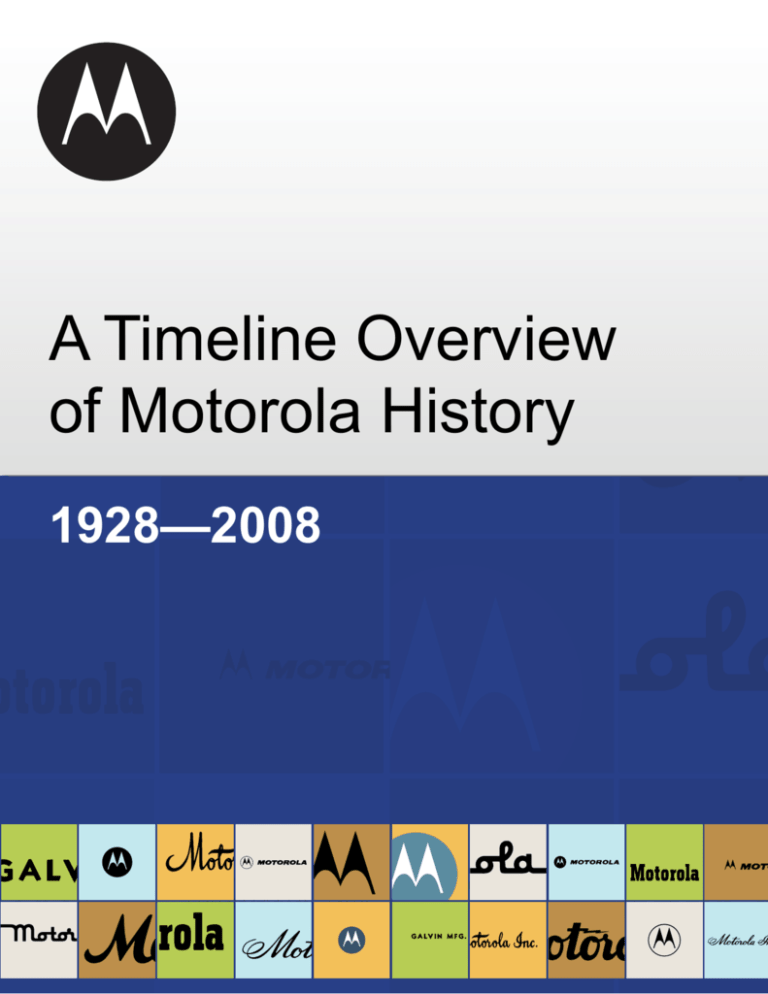
A Timeline Overview
of Motorola History
1928—2008
MOTOROLA HISTORY
A Timeline Overview of Motorola History
1928-2008
A timeline overview of Motorola heritage from its founding as Galvin Manufacturing Corporation
in 1928 to its position today as a global leader in communications and electronics. Events may be
Motorola, industry or world firsts.
1920s
1928 Founding of Company
On September 25, 1928, Paul V. Galvin and his brother,
Joseph, incorporated Motorola’s founding company—the
Galvin Manufacturing Corporation—in Chicago, Illinois,
USA.
1928 Battery Eliminator
Galvin Manufacturing Corporation's first product was a
1928 battery eliminator. This home electronics device
allowed battery-powered radios to run on standard
household electric current. The company’s first customer
was Sears, Roebuck and Co., which sold battery
eliminators to consumers.
1930s
1930
First Motorola Brand Car Radio
In 1930 Galvin Manufacturing Corporation introduced the
Motorola radio, one of the first commercially successful car
radios. Company founder Paul V. Galvin created the brand
Motorola for the car radio—linking "motor" (for motorcar)
with "ola" (which implied sound). Thus the Motorola brand
meant sound in motion.
1930
First Motorola Public Safety Radio Sales
Galvin Manufacturing Corporation began selling Motorola
car radios to police departments and municipalities in 1930.
1936
Police Cruiser Radio Receiver
In 1936 Galvin Manufacturing Corporation introduced the
Motorola Police Cruiser radio receiver, a one-way car radio
designed to receive police broadcasts. The heavy-duty
radio was tuned to a single frequency specified by the
customer.
MOTOROLA and the Stylized M Logo are registered in the US Patent & Trademark Office. © Motorola, Inc. 2008. All rights reserved.
MOTOROLA HISTORY
A Timeline Overview of Motorola History
1928-2008
1937
Home Entertainment Radios
Galvin Manufacturing Corporation entered the home
entertainment business with a 1937 line of Motorola
phonographs and home radios.
1938
National Advertising
The first Motorola national advertising campaign was
underway by 1938. The campaign included print media,
road signs and billboards.
1939
First Motorola Two-Way Radio
In 1939 Galvin Manufacturing Corporation introduced its
first Motorola two-way radio. Public safety officers used the
radio to transmit and receive voice communications from
their cars.
1940s
1940
Handie-Talkie SCR536 Radio
In 1940 Galvin Manufacturing Corporation (later Motorola)
engineers developed the Handie-Talkie SCR536 AM
portable two-way radio. This handheld radio became an
icon on World War II battlefronts.
1940
Research and Development Program
In 1940 Galvin Manufacturing Corporation (later Motorola)
built its research and development program when Daniel E.
Noble, a pioneer in FM radio and semiconductor
technologies, joined the company as director of research.
MOTOROLA and the Stylized M Logo are registered in the US Patent & Trademark Office. © Motorola, Inc. 2008. All rights reserved.
MOTOROLA HISTORY
A Timeline Overview of Motorola History
1928-2008
1940
Sporter Radio
The 1940 Motorola Sporter personal sports radio let people
hear commercial radio broadcasts on the go. The radio
had an antenna in the shoulder strap.
1941
First Motorola Commercial FM Two-Way Radio System
Galvin Manufacturing Corporation introduced its first
commercial line of Motorola FM vehicular two-way radio
systems and equipment in 1941. The first Motorola FM
system was installed in Philadelphia, Pennsylvania, USA.
1943
World's First FM Portable Two-Way Radio
In 1943 Galvin Manufacturing Corporation (later Motorola)
designed the world's first FM portable two-way radio, the
SCR300 backpack model, for the U.S. Army Signal Corps.
Weighing 35 pounds (15.9 kilograms), the "walkie-talkie"
radio had a range of 10 to 20 miles (16-32 kilometers).
1944
First Motorola Business FM Two-Way Radio
In 1944 Galvin Manufacturing Corporation installed
Motorola radios in Yellow Cab Co. taxis in Cleveland, Ohio,
the first commercial FM two-way taxi communications
system in the United States.
1946
Car Radiotelephone
On October 2, 1946, Motorola communications equipment
carried the first calls on Illinois Bell Telephone Company's
new car radiotelephone service in Chicago, Illinois, USA.
1947
Company Name Change
In 1947 Galvin Manufacturing Corporation became
Motorola, Inc.
MOTOROLA and the Stylized M Logo are registered in the US Patent & Trademark Office. © Motorola, Inc. 2008. All rights reserved.
MOTOROLA HISTORY
A Timeline Overview of Motorola History
1928-2008
1947
Dispatcher Two-Way Radios
The 1947 Motorola Dispatcher brand of vehicular two-way
radios used new radio channels for industrial customers in
the United States. Marketing and quality earned Motorola
a leading role in the growing enterprise market.
1947
Motorola's First TV
Motorola's first television, the 1947 Golden View model,
was affordable and popular. More than 100,000 units sold
in one year.
1949
Solid-State R&D
In 1949 Motorola started a research and development
laboratory in Phoenix, Arizona, USA, to research new
solid-state technology.
1950s
1952
Toronto, Canada, Subsidiary
Motorola’s first international subsidiary, Motorola Canada
Ltd., opened in Toronto, Canada, in 1952. The facility
produced radios and televisions.
1953
Motorola Foundation
In 1953 Motorola established the Motorola Foundation to
support leading universities in the United States. The
foundation later expanded to support science, math and
technical education, and human services throughout the
world where Motorola had a major operating presence.
MOTOROLA and the Stylized M Logo are registered in the US Patent & Trademark Office. © Motorola, Inc. 2008. All rights reserved.
MOTOROLA HISTORY
A Timeline Overview of Motorola History
1928-2008
1954 Television and Radio Sales
Televisions and radios were 70 percent of Motorola sales in
1954. Home radios, car radios and TVs featured stylish
designs, colors and materials to appeal to 1950s
consumers.
1955 Stylized "M" Motorola Logo
In June 1955 Motorola introduced a new brand logo, the
stylized "M" insignia, or "emsignia." A company leader said
the two aspiring triangle peaks arching into an abstracted
"M" typified the progressive leadership-minded outlook of
the company.
1955 First Commercial High-Power Transistor
A 1955 Motorola germanium transistor for car radios was
the world's first commercial high-power transistor. It was
also Motorola's first mass-produced semiconductor.
1956 Robert W. Galvin, President
Robert W. Galvin, son of company founder Paul V. Galvin,
became president of Motorola, Inc. in 1956.
1956 Motorola's First Pager
Motorola's first pager, the 1956 Handie-Talkie radio pager,
could send a radio message to a specific person. Pagers
began replacing public announcement systems in hospitals
and factories.
1957 First Pay TV System
Jerrold Electronics, later part of General Instrument and
MOTOROLA and the Stylized M Logo are registered in the US Patent & Trademark Office. © Motorola, Inc. 2008. All rights reserved.
MOTOROLA HISTORY
A Timeline Overview of Motorola History
1928-2008
Motorola, supplied equipment for the first experimental payTV. The Telemovies service offered movies to subscribers
through cable television in Bartlesville, Oklahoma, USA.
1958 Motrac Vehicular Two-Way Radio
In 1958 Motorola introduced the Motrac radio, the world's
first vehicular two-way radio with a fully transistorized
power supply and receiver. Its low power use enabled the
radio to transmit without running the vehicle's engine.
1958 Explorer I Satellite Radio
Beginning in 1958 with Explorer I, an Earth-orbiting
satellite, Motorola provided radio equipment for most NASA
space flights for more than 40 years.
1959 Motorola International, S.A.
In 1959 Motorola established a subsidiary, Motorola
International, S.A., to conduct licensing and manufacturing
for international markets. An office opened in Zurich,
Switzerland.
1960s
1960 Astronaut TV
The 1960 Motorola Astronaut television, a 19-inch model,
was the world's first large-screen, transistorized, cordless
portable television.
MOTOROLA and the Stylized M Logo are registered in the US Patent & Trademark Office. © Motorola, Inc. 2008. All rights reserved.
MOTOROLA HISTORY
A Timeline Overview of Motorola History
1928-2008
1962 HT200 Portable Two-Way Radio
Motorola introduced the transistorized Handie-Talkie HT200
portable two-way radio in 1962. It weighed 33 ounces (935
grams) and was nicknamed the "brick" because of its shape
and durability.
1963 World's First Truly Rectangular Color TV Tube
In 1963 Motorola introduced the world's first truly
rectangular color TV picture tube. The tube, developed in a
joint venture with National Video Corporation, quickly
became the industry standard.
1964 Robert W. Galvin, Chairman and CEO
Robert W. Galvin became chairman of the board and chief
executive officer of Motorola, Inc. on May 15, 1964.
1965 Automotive 8-Track Tape Players
With Ford Motor Company and RCA Corp., Motorola
designed and manufactured 8-track tape players for the
automotive market in 1965.
1965 Transistor Packaging Innovations
Motorola's innovative 1965 design for low-cost plasticencapsulated transistors became a semiconductor industry
standard.
MOTOROLA and the Stylized M Logo are registered in the US Patent & Trademark Office. © Motorola, Inc. 2008. All rights reserved.
MOTOROLA HISTORY
A Timeline Overview of Motorola History
1928-2008
1967 Quasar TV
Motorola's 1967 Quasar color television had an innovative
"Works in a Drawer" design that was easy to service.
1969 First Words From the Moon
A Motorola radio transponder relayed the first words from
the moon to Earth in July 1969. The transponder aboard
the Apollo 11 lunar module transmitted telemetry, tracking,
voice communications and television signals between Earth
and the moon.
1970s
1970 Science Advisory Board Associates (SABA)
In 1970 Motorola formed the Science Advisory Board
Associates (SABA) to recognize outstanding technical
contributions of exceptionally creative Motorola engineers
and scientists.
1971 Broadband Cable Network Standards
In 1971 Motorola Chairman Robert W. Galvin urged the
implementation of broadband cable networks and common
network technical standards in the United States.
1972 Modat Vehicular Data Radio
Motorola's 1972 MODAT mobile data radio system allowed
users in vehicles to transmit data directly to and from
dispatch computers.
MOTOROLA and the Stylized M Logo are registered in the US Patent & Trademark Office. © Motorola, Inc. 2008. All rights reserved.
MOTOROLA HISTORY
A Timeline Overview of Motorola History
1928-2008
1973 Prototype DynaTAC Portable Cellular System
By 1973 Motorola demonstrated a prototype DynaTAC
(DYNamic Adaptive Total Area Coverage) portable
radiotelephone cellular system. A low-power handset was
a fundamental element of the system.
1974 MC6800 Microprocessor
In 1974 Motorola introduced its first microprocessor, the
MC6800 8-bit model. The MC6800 microprocessor was
used in automotive, computing and video game
applications.
1974 Coronary Observation Data Radio
Motorola's 1974 Coronary Observation Radio (COR)
allowed emergency personnel to transmit a patient's
electrocardiogram data to a hospital.
1974 Television Business Exit
Motorola sold its television business, including the wellknown Quasar brand, in 1974.
1975 Apollo-Soyuz Radio
Motorola transponders were used aboard the historic 1975
Apollo-Soyuz "Handshake in Space" docking mission. The
American and Soviet space teams met in Earth's orbit to
test an international docking system and joint flight
procedures.
1975 MX300 Portable Radios
Motorola's 1975 MX300 series of portable two-way radios
operated in the 900 MHz band. They included status,
identification and emergency alert features that were
compatible with computer-aided radio dispatch systems.
MOTOROLA and the Stylized M Logo are registered in the US Patent & Trademark Office. © Motorola, Inc. 2008. All rights reserved.
MOTOROLA HISTORY
A Timeline Overview of Motorola History
1928-2008
1976 New Motorola Headquarters
In 1976 Motorola's international headquarters moved to the
Chicago suburb of Schaumburg, Illinois, USA.
1977 Developmental DynaTAC Cellular System
In 1977 the FCC granted a developmental license for a
Motorola DynaTAC cellular system in the Washington,
D.C.--Baltimore, Maryland, USA, metropolitan area. The
system was operated by American Radio-Telephone
Service, Inc.
1978 RDX 1000 Data Radio
Motorola introduced its first handheld two-way data radio,
the RDX 1000 model, in 1978.
1980s
1980 Ahwatukee Experimental Home
Motorola was a sponsor of the experimental 1980
Ahwatukee home in Arizona, USA. Motorola technologies
controlled information, security, entertainment, electrical,
environmental and energy management systems for
the home.
1980 World's First Computerized Engine Control
In 1980 Motorola and its automotive customers developed
the world's first microprocessor-based engine control, the
EEC III module. The module was designed to reduce fuel
consumption and emissions.
MOTOROLA and the Stylized M Logo are registered in the US Patent & Trademark Office. © Motorola, Inc. 2008. All rights reserved.
MOTOROLA HISTORY
A Timeline Overview of Motorola History
1928-2008
1983 World's First Commercial Portable Cellular Phone
The world's first commercial handheld cellular phone, the
Motorola DynaTAC phone, received approval from the U.S.
Federal Communications Commission on September 21,
1983. The 28-ounce (794-gram) phone became available
to consumers in 1984.
1983 Motorola's First Cellular System
Motorola's first DynaTAC cellular system began commercial
operation in 1983. Over the previous 15 years, the
company invested more than US$100 million in cellular
technology research and development.
1983 KDT 800 Portable Two-Way Data Radio and Network
In 1983 Motorola developed a radio network, later named
ARDIS, that allowed IBM service technicians to use KDT
800 portable two-way data radios to communicate with host
computers. The radios functioned as wireless computer
terminals.
1984 MC68020 Microprocessor
In 1984 Motorola introduced the MC68020, the world's first
true 32-bit microprocessor. The MC68020 microprocessor
contained 200,000 transistors on a three-eighths-inch
square chip.
1986 William J. Weisz, CEO
William J. Weisz became chief executive officer of
Motorola, Inc. in 1986.
MOTOROLA and the Stylized M Logo are registered in the US Patent & Trademark Office. © Motorola, Inc. 2008. All rights reserved.
MOTOROLA HISTORY
A Timeline Overview of Motorola History
1928-2008
1986 Bravo Pager
Motorola introduced the Bravo numeric pager in 1986. It
became the world's best-selling pager.
1986 Six Sigma Quality Process
Motorola invented the Six Sigma quality improvement
process in 1986. Six Sigma provided a common worldwide
language for measuring quality and became a global
standard.
1988 George M.C. Fisher, CEO
George M.C. Fisher became president and chief executive
officer of Motorola, Inc. in 1988.
1988 First U.S. National Quality Award
Motorola was one of three winners of the first Malcolm
Baldrige National Quality Award in 1988. The U.S.
Congress established the award to recognize and inspire
the pursuit of quality in American business.
1989 MicroTAC Personal Cellular Telephone
In April 1989 Motorola launched the MicroTAC personal
cellular telephone, then the smallest and lightest model on
the market.
MOTOROLA and the Stylized M Logo are registered in the US Patent & Trademark Office. © Motorola, Inc. 2008. All rights reserved.
MOTOROLA HISTORY
A Timeline Overview of Motorola History
1928-2008
1990s
1990 First HDTV Technical Standard
In 1990 a Motorola business—then known as General
Instrument Corporation—proposed the first all-digital highdefinition television (HDTV) technical standard.
1991 First GSM Cellular System
Motorola demonstrated the world's first working-prototype
digital cellular system and phones using the GSM (Global
System for Mobile Communications) standard in Hanover,
Germany, in 1991.
1991 World’s First Dual-Mode Cellular Phone
In August 1991 Motorola introduced the world’s first dualmode portable cellular phone, the MicroTAC Lite model.
The MicroTAC Lite phone was compatible with both AMPS
and NAMPS analog cellular transmission standards.
1991 ASTRO Digital Two-Way Radio
Motorola's ASTRO two-way radio system was one of the
first commercial digital radio systems in the industry in
1991.
1993 Gary L. Tooker, CEO
Gary L. Tooker became vice chairman and chief executive
officer of Motorola, Inc. in 1993.
MOTOROLA and the Stylized M Logo are registered in the US Patent & Trademark Office. © Motorola, Inc. 2008. All rights reserved.
MOTOROLA HISTORY
A Timeline Overview of Motorola History
1928-2008
1994 CableComm Interactive System
The 1994 Motorola CableComm interactive system allowed
home cable subscribers to make telephone calls and
access the Internet at higher data rates through home cable
television systems.
1994 iDEN Digital Radio
In 1994 Motorola introduced iDEN digital radio, the world's
first commercial digital radio system that combined paging,
data and cellular communications, and voice dispatch in a
single radio network and handset.
1995 MC68328 DragonBall Microprocessor
Introduced in 1995, Motorola’s DragonBall MC68328
microprocessor was used in consumer electronics such as
handheld video games and personal digital assistants. A
Motorola team in Hong Kong developed the chip.
1995 FORTE CommPad Data Radio
Motorola's FORTE CommPad data radio won the 1995
Industrial Design Excellence Award for communications
equipment. The device contained handwriting recognition
software and a two-way radio.
1995 World’s First Two-Way Pager
In 1995 Motorola introduced the world's first two-way pager,
the Tango two-way personal messaging pager. It allowed
users to receive text messages and email, and reply with a
standard response. It also could be connected to a
computer to download long messages.
1995 RESCU Telematics System
In 1996 Motorola introduced the RESCU emergency
messaging system, a telematics product for drivers of Ford
Motor Company vehicles.
MOTOROLA and the Stylized M Logo are registered in the US Patent & Trademark Office. © Motorola, Inc. 2008. All rights reserved.
MOTOROLA HISTORY
A Timeline Overview of Motorola History
1928-2008
1996 StarTAC Wearable Phone
When introduced in 1996, Motorola's StarTAC wearable
cellular telephone was the world's smallest and lightest. It
weighed just 3.1 ounces (88 grams).
1997 Christopher B. Galvin, CEO
Christopher B. Galvin, grandson of founder Paul V. Galvin,
was elected chief executive officer of Motorola, Inc. in 1997.
1997 Trans European Trunked Radio (TETRA)
In 1997 Motorola's first commercial Trans European
Trunked Radio (TETRA) digital radio system began
operations at Oslo Airport in Gardermoen, Norway.
1997 WisdomPen Chinese Handwriting Software
Motorola introduced the WisdomPen Chinese handwriting
recognition system for portable communication devices in
1997.
1999 iDEN i1000plus Handset
Introduced in 1999, Motorola's iDEN i1000plus handset was
the world's first to combine a digital phone, two-way radio,
alphanumeric pager, Internet microbrowser, email, fax and
two-way messaging.
2000s
MOTOROLA and the Stylized M Logo are registered in the US Patent & Trademark Office. © Motorola, Inc. 2008. All rights reserved.
MOTOROLA HISTORY
A Timeline Overview of Motorola History
1928-2008
2000 World’s First GPRS Cellular System
In June 2000, Motorola and Cisco Systems, Inc. supplied
the world’s first commercial General Packet Radio Service
(GPRS) cellular network to BT Cellnet in the United
Kingdom. The system also used the world’s first GPRS
cellular phone, the Motorola Timeport P7389i model.
2000 Mission-Critical Wireless Data
In 2000 Motorola tested the world's first 700 MHz wideband
high-speed data system for public safety users, enabling
advanced mission-critical solutions. Pinellas County,
Florida, USA, police, fire and EMS services deployed the
trial system in 2001.
2001 IP-Based Digital Communication
In 2001 Motorola's Project 25 and TETRA-compliant IPbased wireless communications systems enabled two-way
radio users to transfer pictures, fingerprints, video and
Internet-based data.
2002 Canopy Wireless Broadband
Introduced in 2002, Motorola's Canopy wireless broadband
platform enabled Internet service providers to deliver
affordable and reliable high-speed Internet access to
homes and small businesses.
2002 Motorola's First 3G Nationwide Network
In 2002 Motorola launched its first 3G nationwide voice and
data network using CDMA 1X technology with KDDI, a
large wireless operator in Japan. The technology enabled
Internet access at speeds more than double that of existing
networks.
2002 World’s First Wireless Cable Modem Gateway
In 2002 Motorola’s SURFboardAE SBG1000 cable modem
gateway was the world’s first to combine a high-speed
cable modem router with an ethernet switch and wireless
home gateway. It enabled cable TV subscribers to use
their cable connection to share Internet access and to
network multiple computers wirelessly.
MOTOROLA and the Stylized M Logo are registered in the US Patent & Trademark Office. © Motorola, Inc. 2008. All rights reserved.
MOTOROLA HISTORY
A Timeline Overview of Motorola History
1928-2008
2003 A760 Cellular Phone
Introduced in 2003, the Motorola A760 cellular phone was
the world's first handset to combine a Linux operating
system and Java technology with full PDA functionality.
2004 Edward J. Zander, Chairman and CEO
Edward J. Zander became chairman and chief executive
officer of Motorola, Inc. in January 2004.
2004 Freescale Semiconductor
Freescale Semiconductor, Inc., formerly Motorola's
Semiconductor Products Sector, began trading on the New
York Stock Exchange as a separate public company in
December 2004.
2004 MOTORAZR V3 Cellular Phone
In 2004 Motorola introduced the RAZR V3 cellular phone,
an ultraslim, metal-clad, quad-band flip phone. The
13.9mm thin phone used aircraft-grade aluminum to
achieve several design and engineering innovations,
including a nickel-plated keypad.
2004 Push-To-Talk Over Cellular
In 2004 Motorola introduced its unique Cross-Technology
Push-To-Talk Over Cellular (PoC) product line that gave
subscribers connectivity among GPRS, CDMA2000 1X and
WiFi networks.
2005 Carbon Nanotube Display
In 2005 Motorola Labs demonstrated a 5-inch color video
display prototype using carbon nanotube technology.
MOTOROLA and the Stylized M Logo are registered in the US Patent & Trademark Office. © Motorola, Inc. 2008. All rights reserved.
MOTOROLA HISTORY
A Timeline Overview of Motorola History
1928-2008
2005 MOTOMESH Broadband Radio Network
In 2005 Motorola’s MOTOMESH wireless mobile network
was one of the first multiradio mesh networks to combine
4.9 GHz licensed mobile broadband radios and unlicensed
Wi-Fi radios into a single access point. Mesh networking
allowed public safety users to rapidly create a network of
wireless devices linked in a relay system.
2006 Motorola MING Smart Phone
Motorola introduced the MING touch screen smart phone in
Asia in 2006. It used advanced handwriting software to
recognize more than 10,000 handwritten characters of the
Chinese alphabet.
2006 National Medal of Technology Ceremony
In a White House ceremony in February 2006, Motorola
received the 2004 National Medal of Technology, the
United States’ highest honor for technological innovation.
Motorola was recognized “for over 75 years of technological
achievement and leadership in the development of
innovative electronic solutions, which have enabled
portable and mobile communications to become the
standard across society.”
2007 Symbol Technologies, Inc.
Motorola acquired Symbol Technologies, Inc. in 2007 to
provide products and systems for enterprise mobility
solutions, including rugged mobile computing, advanced
data capture and radio frequency identification (RFID).
2007 World’s First WiMAX 802.16e Mobile Handoffs
Motorola demonstrated the world's first WiMAX 802.16e
mobile handoffs in downtown Chicago on September 26,
2007. Users experienced live Web browsing and video
streaming sessions on wireless computers while traveling in
the city.
MOTOROLA and the Stylized M Logo are registered in the US Patent & Trademark Office. © Motorola, Inc. 2008. All rights reserved.
MOTOROLA HISTORY
A Timeline Overview of Motorola History
1928-2008
2008 Gregory Q. Brown, CEO and Co-CEO
On January 1, 2008, Gregory Q. Brown became chief
executive officer of Motorola, Inc. He was named co-chief
executive officer of Motorola with Sanjay Jha, and chief
executive officer of Motorola’s Broadband Mobility Solutions
business on August 4, 2008.
2008 Sanjay K. Jha, Co-CEO and CEO
On August 4, 2008, Dr. Sanjay K. Jha became co-chief
executive officer of Motorola and chief executive officer of
Motorola’s Mobile Devices business.
2008 APX Multi-Band Two-Way Radios
Motorola introduced the APX family of Project 25 multiband two-way radios in 2008. Designed with first
responder input, APX radios work in the 700/800 MHz and
VHF bands, and have custom-designed microphones,
integrated GPS, and text messaging.
MOTOROLA and the Stylized M Logo are registered in the US Patent & Trademark Office. © Motorola, Inc. 2008. All rights reserved.

